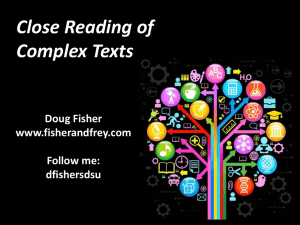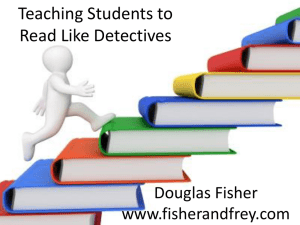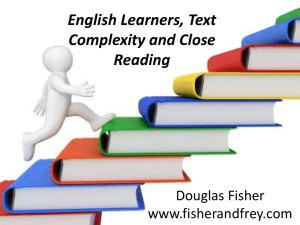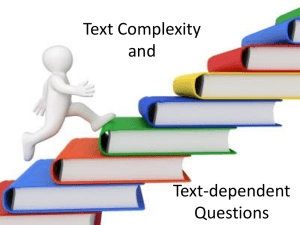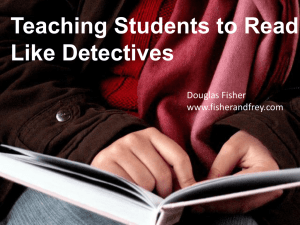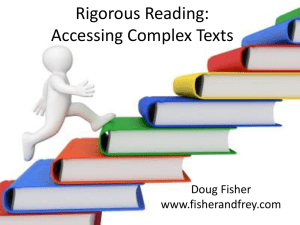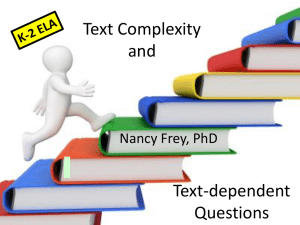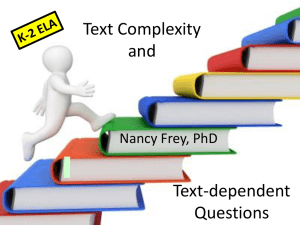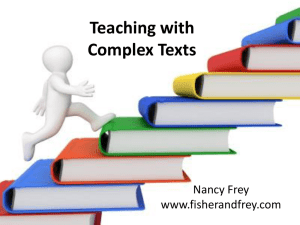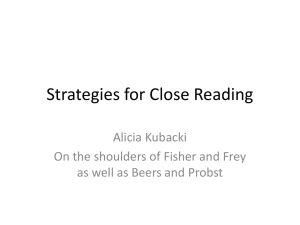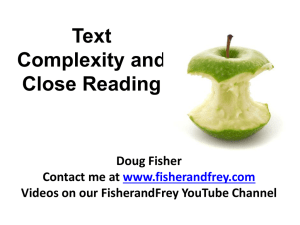Boston, Close Reading
advertisement
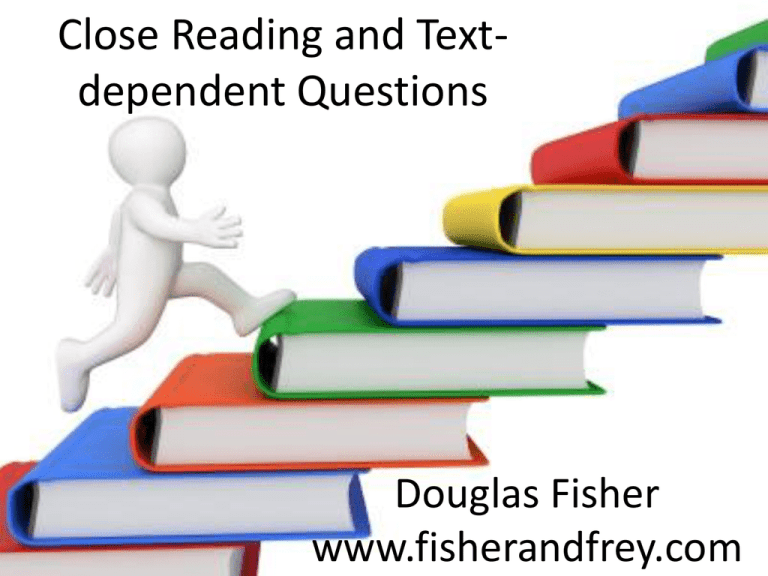
Close Reading and Textdependent Questions Douglas Fisher www.fisherandfrey.com “Read like a detective. Write like a reporter.” —David Coleman Simply assigning hard books will not ensure that students learn at high levels! Close Analytic Reading Creating a Close Reading Use a short passage Creating a Close Reading Use a short passage Re-reading Creating a Close Reading Use a short passage Re-reading “Read with a pencil” Creating a Close Reading Use a short passage Re-reading “Read with a pencil” Text-dependent questions Creating a Close Reading Use a short passage Re-reading “Read with a pencil” Text-dependent questions Give students the chance to struggle a bit Creating a Close Reading A Close Reading of “Salvador, Late or Early” (Cisneros, Woman Hollering Creek and Other Stories, 1991) Text-dependent Questions • Answered through close reading • Evidence comes from text, not information from outside sources • Understanding beyond basic facts • Not recall! Which of the following questions require students to read the text closely? 1. If you were present at the signing of the Declaration of Independence, what would you do? 2. What are the reasons listed in the preamble for supporting their argument to separate from Great Britain? 1. If you were present at the signing of the Declaration of Independence, what would you do? 2. What are the reasons listed in the preamble for supporting their argument to separate from Great Britain? Types of Text-dependent Questions Whole Opinions, Arguments, Intertextual Connections Across texts Inferences Entire text Author’s Purpose Segments Vocab & Text Structure Paragraph Key Details Sentence Word Part General Understandings General Understandings • Overall view • Sequence of information • Story arc • Main claim and evidence • Gist of passage General Understandings in Kindergarten Retell the story in order using the words beginning, middle, and end. Key Details • Search for nuances in meaning • Determine importance of ideas • Find supporting details that support main ideas • Answers who, what, when, where, why, how much, or how many. Key Details in Kindergarten • How long did it take to go from a hatched egg to a butterfly? • What is one food that gave him a stomachache? What is one food that did not him a stomachache? It took more than 3 weeks. He ate for one week, and then “he stayed inside [his cocoon] for more than two weeks.” Foods that did not give him a stomachache • • • • • • Apples Pears Plums Strawberries Oranges Green leaf Foods that gave him a stomachache • • • • • • • • • • Chocolate cake Ice cream Pickle Swiss cheese Salami Lollipop Cherry pie Sausage Cupcake watermelon Vocabulary and Text Structure • Bridges literal and inferential meanings • Denotation • Connotation • Shades of meaning • Figurative language • How organization contributes to meaning Vocabulary in Kindergarten How does the author help us to understand what cocoon means? There is an illustration of the cocoon, and a sentence that reads, “He built a small house, called a cocoon, around himself.” Author’s Purpose • Genre: Entertain? Explain? Inform? Persuade? • Point of view: First-person, third-person limited, omniscient, unreliable narrator • Critical Literacy: Whose story is not represented? Author’s Purpose in Kindergarten Who tells the story—the narrator or the caterpillar? A narrator tells the story, because he uses the words he and his. If it was the caterpillar, he would say I and my. Inferences Probe each argument in persuasive text, each idea in informational text, each key detail in literary text, and observe how these build to a whole. Inferences in Kindergarten The title of the book is The Very Hungry Caterpillar. How do we know he is hungry? The caterpillar ate food every day “but he was still hungry.” On Saturday he ate so much food he got a stomachache! Then he was “a big, fat caterpillar” so he could build a cocoon and turn into a butterfly. Opinions, Arguments, and Intertextual Connections • • • • • • Author’s opinion and reasoning (K-5) Claims Evidence Counterclaims Ethos, Pathos, Logos Rhetoric Links to other texts throughout the grades Opinions and Intertextual Connections in Kindergarten Narrative Informational Is this a happy story or a sad one? How do you know? How are these two books similar? How are they different? Types of Text-dependent Questions Whole Across texts Opinions, Arguments, Intertextual Connections 8&9 Inferences 3&7 Author’s Purpose 6 Entire text Segments Vocab & Text Structure Paragraph Key Details Sentence Word Part Standards General Understandings 4&5 2 1 Annotation is a note of any form made while reading text. “Reading with a pencil.” People have been annotating texts since there have been texts to annotate. Annotation is not highlighting. Annotation slows down the reader in order to deepen understanding. Student’s annotation of connotative meanings in Charlotte’s Web Annotation occurs with digital and print texts. Annotation with Wikki sticks Annotation with smart boards. Annotations in Grades 3-5 • Underline the major points. • Circle keywords or phrases that are confusing or unknown to you. • Use a question mark (?) for questions that you have during the reading. Be sure to write your question. Using Questioning in Fifth Grade Same text, different student, different strategy: Inferring. Annotation in Grades 6-8 • Underline the major points. • Circle keywords or phrases that are confusing or unknown to you. • Use a question mark (?) for questions that you have during the reading. Be sure to write your question. • Use an exclamation mark (!) for things that surprise you, and briefly note what it was that caught your attention. • Draw an arrow (↵) when you make a connection to something inside the text, or to an idea or experience outside the text. Briefly note your connections. Student annotation in 6th grade Student sample from Leigh McEwen, AEA 9, Iowa Annotation in Grades 9-12 • Underline the major points. • Circle keywords or phrases that are confusing or unknown to you. • Use a question mark (?) for questions that you have during the reading. Be sure to write your question. • Use an exclamation mark (!) for things that surprise you, and briefly note what it was that caught your attention. • Draw an arrow (↵) when you make a connection to something inside the text, or to an idea or experience outside the text. Briefly note your connections. • Mark EX when the author provides an example. • Numerate arguments, important ideas, or key details and write words or phrases that restate them. Modeling in 9th Grade English Student annotation in 11th grade English www.fisherandfrey.com
